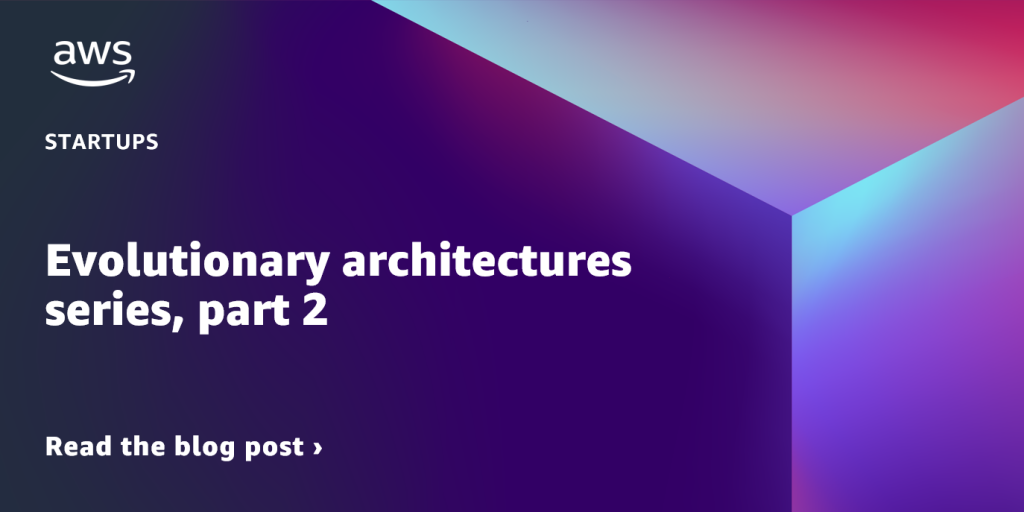AWS Startups Blog
Tag: Advice from AWS Solution Architects
Building a serverless dynamic DNS system with AWS
Build a serverless system using nothing but AWS services and a few lines of code. This simple, cost-effective, and scalable solution allows you to focus on the core business logic of your startup, rather than worrying about scaling and maintaining the underlying infrastructure.
Evolutionary architectures series, part 4
“Evolutionary Architectures” is a four-part blog series that illustrates how solution designs and decisions evolve as companies go through the different stages of the startups lifecycle. In this series, we follow the aptly named Example Startup whose idea is to create a “fantasy stock market” application, similar to fantasy sports leagues. In part 4, we’ll see Example Startup formalizing their security and backup posture to meet various compliance standards, as well as setting a data strategy for the organization and explore additional lines of business to diversify their product portfolio.
Evolutionary architectures series, part 3
“Evolutionary Architectures” is a four-part blog series that shows how solution designs and decisions evolve as companies go through the different stages of the startups lifecycle. In this series, we follow the aptly named Example Startup whose idea is to create a “fantasy stock market” application, similar to fantasy sports leagues. They envision holding four “tournaments” over the course of a year. The second blog described how the startup started evolving their technical solutions while the founders were getting ready for fund raising. In part 3, we will see how Example Startup further progresses in maturing their tech stack and positioning themselves well for scale.
Evolutionary architectures series, part 2
“Evolutionary Architectures” is a four-part blog series that shows how solution designs and decisions evolve as companies go through the different stages of the startups lifecycle. In this series, we follow the aptly named Example Startup whose idea is to create a “fantasy stock market” application, similar to fantasy sports leagues. They envision holding four “tournaments” over the course of a year.
In part 2, we learn how Example Startup continues evolving their solutions to meet an increase in requirements and growth.
Evolutionary architectures series, part 1
Every startup begins as an idea. Before you start worrying about funding or staff or distribution or any of the other myriad things, you have your fresh, new idea—a product or service that you think has potential.
If your idea will rely on the cloud, you’ll need a cloud architecture. This blueprint will help usher your great idea into reality and, if built well, can evolve alongside your business as it grows.
The 10 Cs Super-Successful Startup Founders Have in Common
The qualities that make an uber-successful tech startup founder are a complex, even mystical, blend of traits. As we celebrate the stars of our AWS Software Startup awards, meet three incredible founders who share similar key characteristics and are blazing a distinctive trail.
Migrating your Startup from Firebase to AWS
We occasionally run into startups that built their initial MVP on Firebase but desire to switch to AWS to achieve operations at scale with better data quality and reliability guarantees, and at lower cost. With Firebase consisting of proprietary services, APIs, and an SDK, a migration to AWS requires application refactoring – introducing a new architecture using AWS services, and rewriting parts of the codebase to use them accordingly. To minimize the disruption of this refactoring, this guide will help you identify what AWS services are best suited for your startup’s new architecture along with some implementation strategies to ease and accelerate the cutover.
An Introduction to AWS IoT Core
AWS IoT Core has many features that tackle different challenges IoT customers often have. It can be overwhelming at times to read about them in different places and figure out what exactly to use them for. In this blog post, we go into the different components of AWS IoT Core and walk you through an example of how a fictional startup will use the different components of AWS IoT Core to their benefit.
A Systematic Approach for Analytics Services Migration from GCP to AWS
In this post, we present a systematic approach to guide customers migrating a few commonly used cloud data analytics services from Google Cloud Platform (GCP) to AWS. Rather than a detailed step-by-step implementation guide for a specific service, the post is intended to provide a holistic view and systematic approach for the migrations of these GCP services to AWS.
How Startups Deploy Pretrained Models on Amazon SageMaker
For most machine learning startups, the most valuable resource is time. They want to focus on developing the unique aspects of their business, not managing the dynamic compute infrastructure needed to run their applications. Productionizing machine leaning should be easier, and that’s where AWS comes in. In this blog post and corresponding GitHub repo, you will learn how to bring a pre-trained model to Amazon SageMaker to have production-ready model serving in under 15 minutes.









